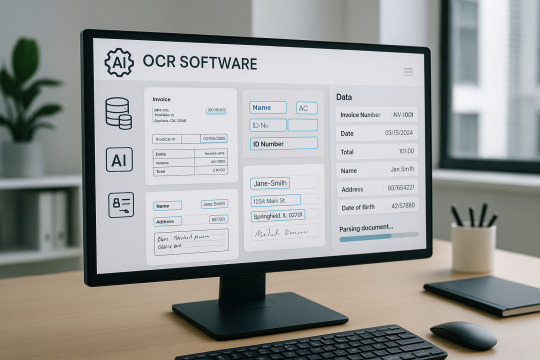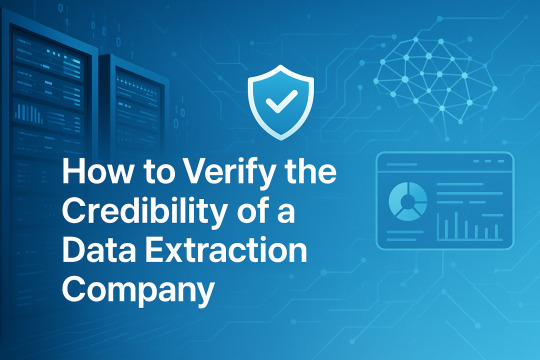#Automate Contract Extraction
Explore tagged Tumblr posts
Text
#Automate Contract Extraction#contract lifecycle management software#contract management system#contract management software#contract management#contract management in procurement#contract lifecycle management
0 notes
Text
Streamlining Business Operations with Advanced Document Automation Solutions
In the present quick moving business climate, overseeing huge measures of records proficiently is vital. With the rising interest for robotization, organizations are going to imaginative advances like Invoice Data Extraction and Contract Data Extraction Software to improve their activities. These arrangements save time as well as fundamentally lessen blunders, guaranteeing that organizations can zero in on development as opposed to managerial undertakings.

The Significance of Invoice Data Extraction
Manual information passage from solicitations isn't just tedious yet in addition inclined to blunders. Invoice Data Extraction programming computerizes this interaction by catching and handling receipt information with high precision. This computerization empowers organizations to smooth out their records payable cycles, guaranteeing that installments are made on time and errors are limited. By utilizing progressed calculations, these apparatuses can remove applicable data, for example, receipt numbers, dates, sums, and provider subtleties, incorporating consistently with existing monetary frameworks.
The Job of a Report Mechanization Stage
A document automation platform assumes an essential part in modernizing business tasks. This stage goes about as a concentrated center where all report related errands are computerized, including information extraction, characterization, and capacity. Organizations can mechanize dreary errands, for example, information section, structure filling, and record age, opening up important HR for additional essential exercises. With the right record mechanization stage, organizations can upgrade efficiency, lessen functional expenses, and work on in general proficiency.
Embracing Cloud Archive Handling
The shift towards distributed computing has reformed the manner in which organizations handle their reports. Cloud record handling offers an adaptable and versatile answer for overseeing huge measures of information. This innovation permits organizations to process, store, and recover records from any area, giving a consistent encounter to remote groups. By utilizing cloud-based arrangements, organizations can guarantee information security, consistence, and openness while lessening the requirement for on-premise foundation.
Amplifying Proficiency with Contract Data Extraction Software
Contracts are essential authoritative records that require fastidious dealing with. Contract information extraction programming robotizes the extraction of key data from contracts, like terms, statements, and lapse dates. This mechanization decreases the gamble of neglecting basic subtleties and guarantees that all authoritative commitments are met. By incorporating contract information extraction programming with a report computerization stage, organizations can deal with their agreements all the more effectively, guaranteeing consistence and limiting lawful dangers.
Conclusion
Consolidating trend setting innovations like Invoice Data Extraction, record robotization stages, cloud report handling, and Contract Data Extraction Software into your business tasks can essentially improve effectiveness and precision. As organizations keep on embracing mechanization, these devices will become irreplaceable in keeping an upper hand in the commercial center. By smoothing out report the board processes, organizations can zero in on advancement and development, driving long haul achievement.
#cloud document processing#automated document processing platform#Invoice data extraction#document automation platform#contract data extraction software#payxtract
0 notes
Text
Stackpack Secures $6.3M to Reinvent Vendor Management in an AI-Driven Business Landscape
New Post has been published on https://thedigitalinsider.com/stackpack-secures-6-3m-to-reinvent-vendor-management-in-an-ai-driven-business-landscape/
Stackpack Secures $6.3M to Reinvent Vendor Management in an AI-Driven Business Landscape


In a world where third-party tools, services, and contractors form the operational backbone of modern companies, Stackpack has raised $6.3 million to bring order to the growing complexity.
Led by Freestyle Capital, the funding round includes support from Elefund, Upside Partnership, Nomad Ventures, Layout Ventures, MSIV Fund, and strategic angels from Intuit, Workday, Affirm, Snapdocs, and xAI.
The funding supports Stackpack’s mission to redefine how businesses manage their expanding vendor networks—an increasingly vital task as organizations now juggle hundreds or even thousands of external partners and platforms.
Turning Chaos into Control
Founded in 2023 by Sara Wyman, formerly of Etsy and Affirm, Stackpack was built to solve a problem she knew too well: modern companies are powered by vendors, yet most still track them with outdated methods—spreadsheets, scattered documents, and guesswork. With SaaS stacks ballooning and AI tools proliferating, unmanaged vendors become silent liabilities.
“Companies call themselves ‘people-first,’ but in reality, they’re becoming ‘vendor-first,’” said Wyman. “There are often 6x more vendors than employees. Yet there’s no system of record to manage that shift—until now.”
Stackpack gives finance and IT teams a unified, AI-powered dashboard that provides real-time visibility into vendor contracts, spend, renewals, and compliance risks. The platform automatically extracts key contract terms like auto-renewal clauses, flags overlapping subscriptions, and even predicts upcoming renewals buried deep in PDFs.
AI That Works Like a Virtual Vendor Manager
Stackpack’s Behavioral AI Engine acts as an intelligent assistant, surfacing hidden cost-saving opportunities, compliance risks, and critical dates. It not only identifies inefficiencies—it takes action, issuing alerts, initiating workflows, and providing recommendations across the vendor lifecycle.
For instance:
Renewal alerts prevent surprise charges.
Spend tracking identifies underused or duplicate tools.
Contract intelligence extracts legal and pricing terms from uploads or integrations with tools like Google Drive.
Approval workflows streamline onboarding and procurement.
This brings the kind of automation once reserved for enterprise procurement platforms like Coupa or SAP to startups and mid-sized businesses—at a fraction of the cost.
A Timely Solution for a Growing Problem
Vendor management has become a boardroom issue. As more companies shift budgets from headcount to outsourced services, compliance and financial oversight have become harder to maintain. Stackpack’s early traction is proof of demand: just months after launch, it’s managing over 10,500 vendors and $510 million in spend across more than 50 customers, including Every Man Jack, Rho, Density, HouseRx, Fexa, and ZeroEyes.
“The CFO is the one left holding the bag when things go wrong,” said Brandon Lee, Accounting Manager at BizzyCar. “Stackpack means we don’t have to cross our fingers every quarter.”
Beyond Visibility: Enabling Smarter Vendor Decisions
Alongside its core platform, Stackpack is launching Requests & Approvals, a lightweight tool to simplify vendor onboarding and purchasing decisions—currently in beta. The feature is already attracting customers looking for faster, more agile alternatives to traditional procurement systems.
With a long-term vision to help companies not only manage but discover and evaluate vendors more strategically, Stackpack is laying the groundwork for a smarter, interconnected vendor ecosystem.
“Every vendor decision carries legal, financial, and security consequences,” said Dave Samuel, General Partner at Freestyle Capital. “Stackpack is building the intelligent infrastructure to manage these relationships proactively.”
The Future of Vendor Operations
As third-party ecosystems grow in size and complexity, Stackpack aims to transform vendor operations from a liability into a competitive advantage. Its AI-powered approach gives companies a modern operating system for vendor management—one that’s scalable, proactive, and deeply integrated into finance and operations.
“This isn’t just about cost control—it’s about running a smarter company,” said Wyman. “Managing your vendors should be as strategic as managing your talent. We’re giving companies the tools to make that possible.”
With fresh funding and a rapidly expanding customer base, Stackpack is poised to become the new standard for how modern businesses manage the partners powering their growth.
#2023#accounting#agile#ai#ai tools#AI-powered#alerts#amp#approach#automation#Behavioral AI#budgets#Building#Business#CFO#chaos#Companies#complexity#compliance#dashboard#dates#documents#EARLY#Ecosystems#employees#engine#enterprise#finance#financial#form
2 notes
·
View notes
Text









I just want an SMT-like that addresses the threat of accelerated consumer tech and the social trends around it in the obvious metaphorical language of ritual occultism, and the long history of scam spiritualism in the victorian era parlor games all the way up to modern era new agers. And not directly related, but I feel like there'd be an implicit, like just utterly unavoidable, undercurrent of automation and labor exploitation and immigrant labor, and reactionary xenophobic attitudes and violent nationalism.
Computers automating complex occult ritual, creating an explosion of ease of access, leading to reckless abuse, summoning demons from another realm, binding people to dangerous contracts, but the demons too, and the growing tension of the foreign influences of those beings facilitating this greed fueled occult-social machine -vs- the entitled and xenophobic human populace. Stupid societal trends and decisions made to combat a "threat" they themselves created, literally conjured out of thin air, all to obtain it they didn't need at a cost level they couldn't afford.



I assume it'd be about a bunch of teen heroes, on the cusp of adulthood, trying to grapple with what agency they have over their lives, what i means to be an adult, and what affordance an increasingly hostile society really gives them for autonomy. but they'd have to make their way through a kind of japanese panorama-of-hell triptych style plot marching their way through scenes of society in mid collapse across differing intersections of class and age groups. You'd get to see how everyone is handling their place in the world and the collapse there of differently; how their will enacted via magic has changed the world around them dramatically, but only in ways that exacerbate all the flaws in their life style and world view as they already existed, and never in any way that actually helps them.


And the real punchline at the bottom of the long trek down the inferno-like apocalyptic nightmarescape is that the demons never wanted to make a hell on earth, it was just humans who wanted a hell they could extract value from.
2 notes
·
View notes
Text
Extractive AI vs. Generative AI: Data Extraction & Precision

What Is Extractive AI?
The goal of the natural language processing (NLP) area of extractive AI is to locate and extract important information from pre-existing data sources. Extractive AI is superior at locating and condensing pertinent information from papers, databases, and other structured or unstructured data formats, in contrast to its generative AI cousin, which produces original material.
Consider it a superpowered search engine that can identify the precise lines or sections that address your question in addition to bringing up webpages. Extractive AI is perfect for applications demanding precision, transparency, and control over the extracted information because of its focused approach.
How Does Extractive AI Work?
A variety of NLP approaches are used by extractive AI, including:
Tokenization breaks text into words or phrases.
Named entity recognition (NER) categorizes people, places, and organizations.
Grammatical functions are assigned to phrase words by part-of-speech tagging.
Semantic analysis examines word meaning and relationships.
By using these methods, extractive AI algorithms examine the data, looking for trends and pinpointing the sections that most closely correspond to the user’s request or needed data.
Rise of Extractive AI in the Enterprise
The growing use of extractive AI across a variety of sectors is expected to propel the worldwide market for this technology to $26.8 billion by 2027. Companies are realizing how useful extractive AI is for improving decision-making, expediting procedures, and deriving more profound insights from their data.
The following are some of the main applications of extractive AI that are propelling its use:
Understanding and summarizing papers: Taking important details out of financial data, legal documents, contracts, and customer evaluations.
Enhancing the precision and effectiveness of search queries in business databases and repositories is known as information retrieval and search.
Collecting and evaluating news stories, social media posts, and market data in order to learn about rival tactics is known as competitive intelligence.
Customer care and support: increasing agent productivity, automating frequently asked questions, and evaluating customer feedback.
Finding suspicious behavior and trends in financial transactions and other data sources is the first step in fraud detection and risk management.
Benefits of Extractive AI
Precision Point Extraction
From unstructured data, such as papers, reports, and even social media, extractive AI is excellent at identifying important facts and statistics. Imagine it as a super-powered highlighter that uses laser concentration to find pertinent bits. This guarantees you never overlook an important element and saves you hours of laborious research.
Knowledge Unlocking
Information that has been extracted is knowledge that has yet to be unlocked; it is not only raw data. These fragments may then be analyzed by AI, which will uncover trends, patterns, and insights that were before obscured by the chaos. This gives companies the ability to improve procedures, make data-driven choices, and get a competitive advantage.
Efficiency Unleashed
Time-consuming and monotonous repetitive jobs include data input and document analysis. By automating these procedures, extractive AI frees up human resources for more complex and imaginative thought. Imagine a workplace where your staff members spend more time utilizing information to create and perform well rather of collecting it.
Transparency Triumphs
The logic of extractive AI is transparent and traceable, in contrast to some AI models. You can examine the precise source of the data and the extraction process. This openness fosters confidence and facilitates confirming the veracity of the learned lessons.
Cost Savings Soar
Extractive AI significantly reduces costs by automating processes and using data. A healthy bottom line is a result of simpler procedures, better decision-making, and lower personnel expenses.
Thus, keep in mind the potential of extractive AI the next time you’re overwhelmed with data. obtaining value, efficiency, and insights that may advance your company is more important than just obtaining information.
The Future Of Extractive AI
Extractive AI has made a name for itself in jobs like summarization and search, but it has much more potential. The following are some fascinating areas where extractive AI has the potential to have a big influence:
Answering questions: Creating intelligent assistants that are able to use context awareness and reasoning to provide complicated answers.
Customizing information and suggestions for each user according to their requirements and preferences is known as personalization.
Fact-checking and verification: Automatically detecting and confirming factual assertions in order to combat misinformation and deception.
Constructing and managing linked information bases to aid in thinking and decision-making is known as knowledge graph creation.
Read more on Govindhtech.com
#ExtractiveAI#GenerativeAI#AI#AIModels#GenAImodels#Riskmanagement#Frauddetection#News#Technews#Technology#Technologynews#Technologytrends#govindhtech
2 notes
·
View notes
Text
Elon Musk hasn’t been sighted at the picket lines in Missouri, Ohio, or Michigan, where autoworkers are striking against the Big Three US carmakers. Yet the influence of Musk and his non-unionized company Tesla have been everywhere since the United Auto Workers called the strike last week. In some ways, Tesla—the world’s most valuable automaker by market capitalization—set the whole thing in motion.
Tesla’s pioneering electric vehicles kicked off a new era that has turned the entire auto industry on its head. In a scramble to compete with Tesla and make that transition, the legacy automakers targeted by the current strike, General Motors, Ford, and Stellantis, have each pledged billions in global investment and have begun dramatically restructuring their operations. For workers, the “green jobs” being created can be scarcer and worse paying. Electric vehicle powertrains have many fewer moving parts than conventional gas-powered ones, and so they require 30 percent fewer vehicle assembly hours, according to one estimate. Plants that make EV batteries are generally outside the core, unionized auto supply chain. The United Auto Workers has seen a dramatic drop in membership due to jobs moving outside the US—it lost 45 percent of its members between 2001 and 2022. A future with more electric vehicles could mean fewer union jobs overall. “This strike is about electrification,” says Mark Barrott, an automotive analyst at the Michigan-based consultancy Plante Moran.
The new assembly plants that the legacy automakers need to pull off the transition have been stood up mostly in US states hostile to union organizing, such as Kentucky, Tennessee, and Alabama. And because many of these plants are joint ventures between automakers and foreign battery companies, they are not subject to previous union contracts.
The UAW did not respond to a request for comment, but UAW president Shawn Fain told CNBC last week that the electric transition can’t leave workers behind. “Workers deserve their share of equity in this economy,” he said.
Tesla’s rise over recent years has also put ever-ratcheting pressure on the legacy automakers to cut costs. Including benefits, Musk’s non-unionized EV company spends $45 per hour on labor, significantly less than the $63 per hour spent in the Big Three, according to industry analysts.
Musk’s willingness to upend auto manufacturing shibboleths has also forced his legacy competitors to seek new efficiencies. Tesla led the way in building large-scale car casts, stamping out very large metal components in one go rather than making a series of small casts that have to be joined together. And it pioneered an automotive chassis building process that can be easily adapted to produce different makes and models.
Tesla’s Silicon Valley roots also helped it become the first automaker to envision the car as a software-first, iPhone-like “platform” that can be modified via over-the-air updates. And the company aims to automate more of its factories, and extract more of the materials it needs to build its batteries itself.
Tesla’s novel production ideas could soon lead the company to put even more pressure on legacy automakers. Musk said earlier this year that Tesla plans to build a new, smaller vehicle that can be made for half the production cost of its most popular (and cheapest) vehicle, the Model 3.
Musk says a lot of things, and many don’t come to pass. (The world is still waiting for the 1 million Tesla robotaxis promised by the end of 2020.) But Tesla has been disruptive enough to leave legacy automakers, including Detroit’s Big Three, “in a quest for capital,” says Marick Masters, who studies labor and workplace issues at Wayne State University's School of Business. Detroit’s automakers have made good money in the past decade—some $250 billion in profits—but also paid a significant chunk of it out in dividends. Pressure from Tesla and the EV transition it catalyzed has left them feeling as if they need every penny they can corral to keep afloat as the industry changes.
“They have little money to concede for union demands,” says Masters. The UAW’s wants include significantly higher wages, especially for workers who have joined the companies since their Great Recession and bankruptcy-era reorganizations, which left some with less pay and reduced pension and health benefits.
So far, the UAW has shown little patience for the idea that the automakers it is pressuring are cash-strapped and under competitive pressure. “Competition is a code word for race to the bottom, and I'm not concerned about Elon Musk building more rocket ships so he can fly into outer space and stuff,” UAW president Fain told CNBC last week when asked about pressure from Tesla. He has argued that production workers should receive the same pay raise received by auto executives over recent years.
When automakers have taken the opposite tack, insisting that they’re well capitalized and making plans to put them ahead of the electric car maker—well, that set up conditions for this strike too. The three American automakers are forecasted to make $32 billion in profits this year, a slight dip from last year’s 10-year high. “The more they toot their own horns about profitability, the more the union looks at them and says, ‘We want our rightful share,’” says Masters.
Tesla did not respond to a request for comment, but Musk has, in typical fashion, chimed in. He posted on X last week to compare working conditions at his companies with the competition, apparently seeking to turn the dispute he helped foment into a recruiting pitch. “Tesla and SpaceX factories have a great vibe. We encourage playing music and having some fun,” he wrote. “We pay more than the UAW btw, but performance expectations are also higher.” A UAW attempt to organize Tesla workers in 2017 and 2018, as the company struggled to produce its Model 3, failed. The National Labor Board ruled that Tesla violated labor laws during the organizing drive; the carmaker has appealed the decision.
5 notes
·
View notes
Note
Shoyo-Bestgirl Feng
Autistic, Gremlin, Excited
Air (Void?)
Cold
Clean (More a constrained chaos)
High-Tech
Hard
Noble (but a scamp)
Violent but probably lack of context for otherwise
Unsure? Government or Corporate maybe?
Augmented (Genetic Enhancements)
Military Officer, Professional Go Player, Wildlife Caretaker
Swords and they're the sharpest ever, Is nonverbal so probably communicates in an alternative fashion to others from her mech
[ For I'll write an Armored Core VI Verse/AU for your muse ]
World: Uranus (Sol 7) Catalog Number: n/a Type: ice giant, various colonies Climate: artificial, temperate Population: 12 million Satellites: 27 Notable Features: orbital ring and dockyards
Helium-3, the lifeblood of the interstellar economy, is not an easy thing to acquire at industrial scales. Lunar deposits were costly to extract and rapidly overexploited to fuel human industry. While insatiable demand drove the early development of the Jupiter colonies, Jupiter's deep gravity well, intense radiation belts, and differentiated atmosphere made atmospheric mining at scale prohibitively costly. Saturn was ultimately little better, and the market was primed for a cheaper supply. Uranus, with a much weaker gravity well and more importantly still an unsettled distribution of helium, was exactly what humanity needed, despite being located at a markedly greater distance. The ease of extracting power from its magnetic field, which is tilted from the rotation of the planet, was another plus.
Today, Uranus hosts a largely automated helium-3 extraction industry, providing the bulk of the supply in Sol and neighboring systems. Atmospheric mining is conducted via massive atmospheric platforms—part aerostat, part aircraft—which routinely transfer their haul to low orbit via cargo drones. These are subsequently collected by skyhooks descending from the orbital ring. This ring, having been constructed through extensive mining of the Uranian moons, hosts most of the human population, and sustains itself using volatiles from the planet and ices from said moons. While the orbital ring is under the tight control of a unified governing authority practicing dirigiste economic policies, the resulting "national champion" corporations promote the interests of Uranus vigorously, not just in the remaining early colonies of closed O'Neill cylinders around the planet, or on its moons, but throughout the outer Solar System—much to the chagrin of the Jupiter colonies.
Name: Shoyo Fēng Augmentation: Generation Nine Occupation: corporate security officer Affiliation: Fēng Tactical Solutions Registration Number: Sl4649 Callsign: Tacit Armored Core: Intervals
Although most of the Uranian corporations have their own internal security details, external physical security is almost inevitably contracted to Fēng Tactical Solutions, which de facto constitutes the Uranian military and is publicly traded but majority-controlled by its namesake family. Given their limited recruitment pool and the need to function across a wide range of environments (so-called ECOAS operations—earth, colony, asteroid), the company places a particular emphasis on skill and first strike capability to minimize losses. Their defensive forces are limited and their offensive forces are organized into role-specific strike teams.
The newest member of the Fēng family to appear in the corporation's combat roster, Shoyo was initially assigned to a Muscle Tracer guard unit, but proved to be a poor fit for the duty assignment despite her stellar simulation scores. It was eventually judged that her talents were being wasted, and she was reassigned to an Armored Core-based reconnaissance and scouting team. The unit in question routinely dispatches its members solo and notably farther afield than the usual stalking grounds of the outer Solar System, to include other systems.
While Shoyo's unusual text-and-gesture-only style of communication proved a hindrance in team formations, the cryptic impression it leaves has proven oddly fitting to her new line of work.

A fairly high-tech AC, Intervals was—perhaps somewhat paradoxically to those from more terrestrial backgrounds—constructed with melee combat in mind. Relatively nimble while retaining good armor and defense, it features higher stability for its weight.
Functionally a light assault unit, its typical combat pattern is closing with assault boost while using vertical plasma missiles to suppress targets, then continuing to apply pressure with its machine gun as it closes to melee range. The laser blade provides excellent mobility in this regime and can sweep multiple targets, while its laser slicer and assault armor make for devastating follow-ups. A nightmare once it's within enemy ranks, it also poses a substantial threat to any AC that would underestimate its close-range power.
#Out Of Character#maddmuses#Armored Core RP#Armored Core Roleplay#Long Post#Asks#Ask Games#[ Uranus is basically Space Norway ]
2 notes
·
View notes
Text
Intelligent by Design: How LLM Development Gives Businesses a Competitive Edge

In the age of intelligent automation, businesses are no longer asking if they should adopt AI—they’re asking how. And at the heart of this digital transformation is a powerful, adaptable technology: Large Language Models (LLMs).
From chatbots that can handle thousands of customer queries to smart assistants that draft proposals or analyze financial documents, LLM development is proving to be the secret weapon for organizations seeking speed, scalability, and strategic advantage.
In this article, we’ll explore how LLMs are reshaping enterprise intelligence, what goes into developing them, and why businesses that embrace this shift will lead their industries into the future.
What Are LLMs and Why Do They Matter?
Large Language Models are AI systems trained on massive amounts of text data. Using neural networks (specifically, transformer architectures), they learn patterns in language and develop a remarkable ability to generate and interpret human-like text.
Unlike narrow AI tools, LLMs are versatile. With the right development and customization, a single model can:
Answer customer questions
Generate business reports
Translate documents
Write software code
Summarize legal contracts
Create marketing content
In short, they act as a flexible layer of intelligence across departments.
The Rise of LLM Development in the Enterprise
While many businesses are experimenting with tools like ChatGPT, true transformation comes when organizations develop custom LLM solutions tailored to their data, workflows, and goals.
That’s where LLM development comes in: a combination of engineering, training, integration, and optimization that turns a general-purpose model into a high-impact enterprise tool.
Here’s what this development process typically involves:
1. Use Case Discovery
Identify the most valuable problems LLMs can solve—customer service, document processing, content generation, etc.
2. Data Strategy
Use your proprietary data—documents, chats, reports—to fine-tune models and ensure contextual accuracy.
3. Model Selection
Choose between open-source models (like LLaMA, Mistral, Falcon) or commercial APIs (like GPT-4, Claude, Gemini) based on your needs.
4. Customization
Fine-tune the model for tone, style, terminology, or use domain-specific instruction sets through prompt engineering.
5. Deployment
Securely host the model behind internal APIs or embed it directly into enterprise applications.
6. Monitoring & Improvement
Track performance, user feedback, and accuracy. Retrain or adjust prompts as needed to improve results.
Why Businesses Are Investing in LLM Development Now
The business case for LLMs is no longer hypothetical. It’s here—and it’s compelling.
Efficiency Gains
LLMs automate repetitive knowledge work. What took 2 hours can now take 20 seconds—with consistent quality.
Scalable Intelligence
They enable human-like interaction across thousands of users simultaneously—perfect for customer service, HR support, or employee training.
Knowledge Access
LLMs make it easy to query unstructured data—like internal documents, research papers, or product manuals—using natural language.
Decision Support
They can extract insights, compare options, and suggest actions—helping executives and teams make informed decisions faster.
Real-World Examples of LLM-Driven Business Innovation
Finance
Banks are using LLMs to generate risk reports, automate compliance documentation, and build intelligent investor chatbots.
Healthcare
Medical organizations deploy LLMs to summarize patient records, assist with diagnosis documentation, and power 24/7 symptom checkers.
E-Commerce
Online retailers use LLMs for product description generation, review analysis, and intelligent shopping assistants.
Legal
Law firms deploy LLMs to read and compare contracts, find relevant precedents, and draft summaries of lengthy case law.
Build or Buy? The Role of LLM Development Companies
While off-the-shelf tools are useful for experimentation, building production-grade LLM applications requires significant technical and strategic expertise. That’s where LLM development company come in.
A trusted development partner can help you:
Assess business needs and AI readiness
Select and fine-tune the right models
Ensure data privacy and compliance
Create intuitive, secure interfaces
Deploy solutions that scale
Monitor for alignment, bias, and performance
They don’t just write code—they help you build competitive advantage through custom, context-aware AI systems.
Key Considerations Before You Start
Before diving into LLM development, here are a few important things to consider:
Data Privacy & Security
Sensitive internal data must be protected during training and usage. Ensure your partner understands compliance frameworks (GDPR, HIPAA, etc.).
Infrastructure
Do you need in-house deployment or will you use cloud APIs? Each has pros and cons for latency, cost, and control.
ROI Focus
Start small with high-impact use cases. Pilot projects in marketing, support, or operations can prove value quickly.
Ethical AI
Develop policies and safeguards to prevent bias, misuse, or harmful content generation.
The Future: AI Copilots for Every Role
Imagine every employee in your organization having an AI assistant—trained on company knowledge, fluent in their tasks, and always available. That’s the vision LLM development makes possible.
Soon, we won’t just use software—we’ll converse with it. We’ll delegate research, documentation, communication, and even decision-making to AI-powered systems that learn, adapt, and improve over time.
By investing in LLM development today, you’re building the foundation for that intelligent, collaborative future.
Final Thoughts
LLM development is no longer just an R&D experiment—it’s a core strategy for future-ready businesses.
Companies that harness the power of LLMs now will:
Move faster than competitors
Innovate across departments
Create better customer experiences
Build more resilient, efficient teams
The language of business is changing—and with LLMs, you can speak it fluently.
0 notes
Text
Accurate Barcode Recognition in Legal and Contract Management Systems Using SDK
Every Monday morning, I used to dread sifting through stacks of contracts and legal documents, each with tiny, barely visible barcodes stamped somewhere in the corner. Tracking, verifying, and organising them was a nightmare — especially when some barcodes were smudged or faded. I needed a solution that could handle those messy real-world conditions without slowing me down. That’s when I discovered the VeryUtils JavaScript Barcode Scanner SDK for Developers Royalty Free — a game-changer for anyone working in legal or contract management systems.
Why Barcode Scanning Matters in Legal and Contract Management
Handling legal documents means juggling huge volumes of paperwork, many of which come with barcodes encoding crucial tracking and reference info. Accurate barcode recognition isn't just about scanning; it’s about cutting down errors, speeding up workflows, and ensuring compliance. Without a reliable scanner, you're stuck with tedious manual entry or error-prone data capture that eats up your time and patience.
This is where VeryUtils’ barcode scanner SDK shines. It’s designed for developers who want to embed fast, precise barcode scanning right into their apps or websites — without the usual headaches of complicated setup or unreliable performance.
What is the VeryUtils JavaScript Barcode Scanner SDK?
This SDK is a JavaScript-based barcode scanning toolkit that transforms mobile devices and desktops into powerful barcode readers — no extra hardware needed. It’s royalty-free, so once you get it, you’re free to build whatever barcode scanning feature your app requires.
At its core, it’s built for speed and reliability, with AI-powered algorithms that can decode barcodes under the toughest conditions. Whether you’re dealing with 1D barcodes like EAN or 2D codes like QR and Data Matrix, this SDK handles them all seamlessly. It’s perfect for developers in legal, logistics, retail, healthcare — honestly, anywhere barcodes matter.
Who Benefits Most from This SDK?
Legal and Contract Management Professionals: Quickly scan barcodes on contracts, case files, or evidence documents.
Developers Building Enterprise Solutions: Add barcode scanning to document management or compliance software.
Logistics and Warehouse Managers: Batch scan multiple packages, track shipments, and reduce errors.
Retail and Inventory Teams: Manage stock, verify shipments, and speed up checkout.
Healthcare Admins: Track medical supplies and patient documents efficiently.
Key Features That Make It a Winner
Context-Aware AI Scanning Engine The AI behind the scanner only extracts the barcodes you actually need. No more clutter or false positives, even in noisy, complicated label environments. For me, this meant no more sifting through irrelevant codes on contract envelopes or package labels.
Multiple Barcode Scanning and Augmented Reality (AR) Overlays You can scan several barcodes at once or in batches. The AR feature overlays real-time insights on the screen, making it easy to verify that you scanned the right codes without second-guessing.
Fully Automated Label Scanning The SDK can simultaneously read printed text and barcodes on labels, which saved me tons of time extracting key info from legal documents where barcodes and text go hand in hand.
Ready-To-Use UI Components I got started in less than an hour, thanks to the customizable UI elements. No deep dive into complex coding was needed to fit the scanner neatly into my existing web app.
Cross-Platform Compatibility Works smoothly on all major browsers and mobile devices, whether you’re using iOS, Android, or desktop browsers like Chrome and Firefox.
Robust in Challenging Conditions Barcodes were damaged, tiny, or in low light? No problem. The SDK’s advanced algorithms handled all of these situations without hiccups.
Real-Life Impact: How This SDK Changed My Workflow
Before I started using the VeryUtils JavaScript Barcode Scanner, every contract intake session felt like a bottleneck. I’d manually cross-check barcodes or scan with generic apps that often missed damaged labels. On busy days, this caused delays and mistakes.
Integrating this SDK into our contract management system changed the game:
Speed: Batch scanning allowed me to quickly capture dozens of barcodes in one go. It cut down my scanning time by at least 50%.
Accuracy: The AI-driven context recognition meant no more false reads or irrelevant data. It even read partial or worn barcodes flawlessly.
User Experience: The AR overlay gave instant visual confirmation, so I never doubted if I grabbed the right document. It felt like having a super-powered assistant.
Flexibility: Customising the UI to match our system’s design was straightforward. The seamless integration impressed both our tech team and end-users.
If you’ve ever struggled with barcode scanning in legal or contract management environments, you know how frustrating it can be. This SDK takes those frustrations away.
How Does It Compare to Other Tools?
I tested several popular barcode scanning solutions before settling on VeryUtils, and here’s what stood out:
Many tools rely on hardware scanners or bulky apps that don’t integrate well into web environments. VeryUtils runs directly in JavaScript, making it much lighter and more flexible.
Other SDKs often struggle with batch scanning or real-time AR feedback. VeryUtils nails both.
The AI-driven selective scanning feature is unique. It prevents unnecessary noise, unlike most competitors that scan everything indiscriminately.
Enterprise-level support and royalty-free licensing gave me confidence that this was a solid long-term choice.
Where Can You Use This SDK?
Legal Offices: Automate contract indexing, tracking, and archiving.
Contract Management Systems: Ensure documents are properly logged with barcode references.
Logistics: Batch scan multiple shipments or documents in one pass.
Retail: Speed up inventory checks and product lookups.
Healthcare: Track medical supplies and patient documentation with precision.
Getting Started with VeryUtils JavaScript Barcode Scanner SDK
It’s super easy to set up:
Add the library via CDN or npm.
Choose from over 30 barcode symbologies.
Customize listener methods to fit your workflow.
No complex hardware needed — just use your device camera or upload images.
Why I’d Recommend This SDK to Developers and Legal Teams
If you handle legal contracts or any barcode-heavy document workflows, this SDK will save you headaches and hours.
It’s fast, smart, and reliable, even when barcodes aren’t picture-perfect. The batch and multi-scan modes are especially helpful for busy environments where speed and accuracy are non-negotiable.
Plus, the developer-friendly design means you can get it working in your app with minimal fuss.
Ready to boost your legal and contract management system with accurate barcode scanning?
Click here to try it out for yourself: https://veryutils.com/javascript-barcode-scanner-sdk Start your free trial now and experience faster, smarter barcode recognition.
Custom Development Services by VeryUtils
VeryUtils doesn’t just stop at barcode scanning SDKs. They offer custom development services to fit your unique needs across many platforms:
Custom PDF processing solutions for Windows, Linux, macOS, and server environments.
Utilities built on Python, PHP, C/C++, JavaScript, .NET, and more.
Windows Virtual Printer Drivers generating PDF, EMF, TIFF, and other formats.
Advanced tools for intercepting and capturing print jobs from all Windows printers.
Deep expertise in document formats like PDF, PCL, Postscript, and EPS.
Barcode generation and recognition, OCR, layout analysis, and table extraction.
Cloud-based solutions for digital signatures, document conversion, and security.
If you have a complex project that demands tailored tech solutions, VeryUtils is worth reaching out to: https://support.verypdf.com/
FAQs
What barcode types does the VeryUtils JavaScript Barcode Scanner SDK support? It supports over 30 symbologies, including QR codes, Data Matrix, PDF417, EAN, UPC, Code 128, and more.
Can I scan multiple barcodes at once? Yes. The SDK supports batch scanning, multi-scanning, and even real-time AR overlays to enhance user experience.
Does the SDK work on mobile devices? Absolutely. It supports all major browsers on iOS and Android devices, ensuring cross-platform compatibility.
How secure is barcode scanning with VeryUtils? VeryUtils is ISO27001 certified, ensuring your data stays private and secure. You retain full control over data processing.
Can I customise the scanner’s UI to match my app’s look? Yes. The Ready-To-Use UI component is highly customizable, or you can build a custom UI using their SDK components.
Tags / Keywords
Accurate barcode recognition
Legal contract barcode scanning
JavaScript barcode scanner SDK
Batch barcode scanning
Barcode scanning for legal management
Barcode reader for web apps
Contract management system barcode
Barcode scanning SDK developer tool
VeryUtils barcode scanner
Cross-platform barcode scanning
If you’re serious about speeding up your legal or contract management workflows with reliable, smart barcode scanning, the VeryUtils JavaScript Barcode Scanner SDK is exactly what you need. I’ve been there — and this tool made all the difference.
0 notes
Text
Government operations rely heavily on outdated technologies like COBOL, mainframes, .NET, and Java, each contributing to inefficiencies in procurement and resource management. These systems, combined with resistance to change and inefficient contractor processes, create bottlenecks, inflate costs, and hinder modernization. Data silos, manual processes, and rigid contracts exacerbate waste, with a 2023 GAO report estimating 70% of federal IT systems are outdated, costing billions annually. AI tools like Grok, Amazon Bedrock, Rossum, and Domo can address these issues by leveraging data lakes, automating code development, accelerating document processing, and reducing manual data handling. Below, each technology’s issues and benefits are outlined, followed by how AI tools can drive modernization.
COBOL, prevalent in mainframe-based systems, powers critical government applications like financial and payroll systems. Its benefits include reliability for high-volume transaction processing and a vast existing codebase, with over 220 billion lines still in use globally. However, COBOL’s age—developed in the 1950s—makes it incompatible with modern cloud architectures. Its rigid syntax slows development, and a shrinking pool of skilled programmers increases maintenance costs, often exceeding $100,000 per developer annually. Data silos in COBOL systems hinder real-time analytics, delaying procurement decisions.
Mainframes, the backbone of many government IT systems, excel in processing large-scale, mission-critical workloads with 99.999% uptime. They handle billions of transactions daily, supporting agencies like the IRS. Yet, mainframes are costly, with annual maintenance fees reaching millions per system. Their proprietary nature locks agencies into vendor contracts, stifling innovation. Lack of interoperability with modern platforms creates data silos, complicating integration with tools like data lakes.
.NET, widely used for government web applications, offers robust integration with Windows ecosystems and strong security features, ideal for sensitive data. Its developer-friendly framework supports rapid prototyping, and open-source versions like .NET Core enable cross-platform deployment. However, legacy .NET applications often rely on outdated Windows servers, vulnerable to cyberattacks. Frequent updates require constant retraining, and compatibility issues with non-Microsoft systems limit flexibility, slowing procurement modernization.
Java, a staple for enterprise applications, benefits from platform independence and a vast ecosystem of libraries, enabling scalability across government systems. Its open-source nature reduces licensing costs, and strong community support ensures longevity. However, Java’s complexity leads to longer development cycles, with verbose code increasing debugging time by 20-30% compared to modern languages. Legacy Java applications often run on outdated servers, creating security risks and integration challenges with cloud-based data lakes.
AI tools can mitigate these issues. Grok, from xAI, leverages data lakes to unify siloed COBOL and mainframe data, providing real-time procurement insights. For example, it can analyze spending patterns to eliminate redundancies, saving millions. Amazon Bedrock automates document processing, extracting data from COBOL-generated reports in minutes, reducing manual work by 80%. Rossum’s AI OCR processes unstructured documents from .NET or Java-based systems, achieving 99% accuracy and eliminating manual data entry. Domo’s automated dataflows integrate mainframe and Java data, enabling predictive analytics for resource allocation.
These tools also streamline code development. Grok generates and debugs code for .NET and Java, cutting development time by up to 50%. Amazon Bedrock’s APIs simplify integration of legacy systems with cloud platforms, reducing mainframe dependency. Automation removes humans from repetitive tasks—Rossum’s AI learns from annotations to improve data extraction, while Domo automates data cleaning, reducing errors by 90%. Agencies should adopt data lakes for centralized data access, use shorter performance-based contracts to encourage innovation, and run pilot programs to demonstrate AI-driven efficiencies, like automating contract audits in hours instead of weeks. Training programs can upskill staff, easing resistance to change. By leveraging these tools, government agencies can overcome the limitations of COBOL, mainframes, .NET, and Java, achieving cost savings and enhanced mission outcomes.
0 notes
Text
Intelligent OCR Software: The Smart Way to Automate Document Processing

In a world where businesses are generating and handling thousands of documents every day, traditional Optical Character Recognition (OCR) is no longer enough. Enter Intelligent OCR Software — a smarter, faster, and more accurate way to extract data from scanned documents, PDFs, handwritten notes, and images.
Whether you're dealing with invoices, ID cards, contracts, or forms, AI-powered OCR helps automate the document workflow with unmatched efficiency and precision.
What is Intelligent OCR Software?
Intelligent OCR software goes beyond basic text recognition. It uses machine learning (ML), natural language processing (NLP), and artificial intelligence (AI) to understand the context of the text, recognize complex patterns, and make decisions based on the document’s structure.
Unlike traditional OCR, which simply converts images into text, smart OCR solutions can:
Extract structured and unstructured data
Understand tables, fields, and layouts
Recognize handwriting and low-quality scans
Classify document types automatically
Why Businesses Need AI-Powered OCR
Here’s why companies across industries are turning to AI-powered OCR:
1. Speed & Scalability Process thousands of documents in minutes without compromising accuracy.
2. Higher Accuracy OCR with machine learning improves over time, reducing errors from misreads or poor-quality scans.
3. Contextual Understanding Unlike rule-based systems, intelligent OCR understands the document's layout and meaning.
4. Automation-Ready Seamlessly integrates into document automation workflows to reduce manual labor and operational cost.
Key Features of a Smart OCR Solution
AI & ML-Powered Engine: Learns from patterns and corrections to enhance accuracy.
Handwriting Recognition: Reads cursive and printed handwriting accurately.
Multi-language Support: Processes documents in multiple global languages.
Template-Free Processing: No need for predefined formats—ideal for variable forms.
Cloud & API Access: Easily integrates with ERPs, CRMs, and cloud storage.
Use Cases of Intelligent OCR Across Industries
Industry
Use Case
Finance
Invoice and receipt digitization, KYC verification
Healthcare
Patient form processing, insurance claims
Legal
Contract digitization and clause extraction
Education
Exam sheet scanning, student enrollment forms
Retail
Order forms, delivery notes, payment receipts
Makezai’s Smart OCR Solution
At Makezai, we offer a state-of-the-art intelligent OCR software that combines machine learning, AI, and natural language processing to help businesses:
Extract data from diverse document types
Automate end-to-end processing workflows
Reduce manual errors
Improve compliance and audit readiness
Whether you're a small business or a large enterprise, our smart OCR solution is designed to scale with your needs.
Future-Proof Your Document Processing
As digital transformation accelerates, businesses that adopt intelligent OCR software will lead the way in automation, efficiency, and cost savings. By investing in a smart OCR solution, you’re not just digitizing documents—you’re unlocking real-time data, improving accuracy, and creating smarter workflows.
Ready to automate your documents with AI?
Contact Makezai today to discover how our AI-powered OCR can revolutionize your document processes and take your operations to the next level.
0 notes
Text
Mastering AML and KYC in Stablecoins
The U.S.-backed stablecoin market is evolving rapidly, and with stringent new federal regulations now in effect, everyone involved in the American digital finance space needs to quickly get up to speed. After lengthy negotiations, the GENIUS Act now establishes the nationwide framework governing who can issue stablecoins, what disclosures about reserves are required, and—most importantly—how issuers must handle anti-money laundering (AML) and know-your-customer (KYC) obligations similar to traditional banks. Whether you're an investor, developer, or simply interested, these developments call for updated strategies, more robust technology, and highly refined compliance measures across the industry.
The New Landscape: What the GENIUS Act Requires
Enacted in June 2025, the GENIUS Act represents the first comprehensive federal regulatory framework targeting payment stablecoins specifically. Issuance is now restricted to banks, authorized top-tier state entities, and other closely regulated entities, sharply reducing the opportunities for smaller or lightly supervised projects to legally operate within the U.S.
Each stablecoin must be backed by an equivalent amount of reserves held one-to-one, with ongoing public disclosures ensuring transparency about what underpins their value. At the same time, issuers are legally recognized as full financial institutions, requiring them to implement thorough AML procedures and in-depth KYC checks on users—while maintaining robust monitoring systems for suspicious activities and sanctions compliance.
One particularly challenging requirement is the mandate that issuers possess technology capable of blocking, freezing, or even “burning” specific stablecoins if compelled by lawful orders from law enforcement. Implementing these controls at blockchain scale demands significant code modifications and platform upgrades, which are currently underway across the U.S. market. Moreover, foreign stablecoins aiming to access U.S. users must comply with these stringent regulatory and compliance mandates, or risk being excluded.
RegTech: Navigating Compliance with Sophisticated Tools
Under the new legal framework, possessing advanced technology isn’t optional—it’s essential. Top RegTech providers now offer AI-powered systems that monitor blockchain transactions in real time, instantly distinguishing between normal behavior and suspicious patterns. These automated platforms detect tainted coins and dubious wallet behaviors far more quickly and effectively than manual ledger inspections.
To meet these regulatory tech standards, many stablecoin issuers are embedding compliance requirements directly into their codebases: if legally mandated, smart contracts will immediately freeze targeted wallets. Automation tools also generate compliance reports by extracting audit logs directly from fast-moving blockchain data, significantly reducing paperwork and human mistakes. KYC solutions have become more sophisticated as well, featuring digital identity verification tailored for crypto’s privacy levels, global wallet holders, and high-risk edge cases. The ultimate aim is to enable providers to verify customer identities accurately and identify illicit actions proactively before trust erodes.
Industry Dynamics: Complexity and Challenges
The fast transaction speeds and pseudonymous nature of U.S. stablecoins create unique compliance challenges. Although blockchain records are theoretically transparent, linking anonymous wallet addresses to real individuals remains difficult. Consequently, funds can transfer rapidly without the typical warning signs that banks use to detect wrongdoing. Regulators now demand more rigorous KYC onboarding processes and require companies to maintain detailed logs that are readily accessible if transactions later come under investigation. Suspicious Activity Reports (SARs), once infrequent, are becoming far more common as compliance teams race to keep pace.
The decentralized finance (DeFi) ecosystem, which largely operates via smart contracts, complicates matters further. Since most DeFi applications rely on stablecoins but offer almost no traditional customer onboarding, they present significant AML risks. Even well-intentioned participants might unwittingly violate regulations. U.S. rules now align with recommendations from the Financial Action Task Force (FATF), urging domestic players to follow global best practices or risk exclusion from compliant networks.
Risk-based compliance models are now standard. Stablecoin issuers, exchanges, and fintech companies must deploy AI-driven profiling to scrutinize users, intensify monitoring for unusually large or suspicious transactions, and maintain meticulous records enabling investigation backtracking—even years later. Transparent audit trails aren’t optional—they’re a legal necessity.
Best Practices: Insights from Leading Industry Players
For stablecoin issuers, regulatory compliance is now embedded at the core of token architecture to ensure instant responses to regulatory or judicial actions. Modular RegTech solutions allow quick adaptation to changing compliance rules, especially useful for handling evolving cross-border regulations or amendments issued by the SEC. Leading RegTech firms like Chainalysis, Elliptic, and AiPrise offer comprehensive analytics platforms, wallet risk scores, and automated KYC tools to accelerate investigations and help identify suspicious activity long before authorities intervene.
Traditional financial institutions working with stablecoins are mandated to segregate client tokens from their corporate holdings and provide specialized training to compliance teams on blockchain-specific risks rather than only familiar financial fraud. Enhanced crypto-focused internal audits are required, considerably increasing operational workload. Regulators emphasize standardizing blockchain monitoring solutions and coordinating internationally to prevent criminals from exploiting regulatory gaps across jurisdictions. The era of disparate, disjointed compliance systems is poised to end—at least in theory.
Key Takeaways for Investors, Fintechs, and Crypto Participants
With so many evolving factors, what should those interacting with U.S. stablecoins keep in mind?
Investors: Focus on stablecoins issued by well-regulated entities with clear compliance histories and transparent audit trails to minimize the risk of freezing or legal complications. Verify your wallet provider’s vetting processes before transferring funds.
Fintech companies: Integrate sophisticated compliance technologies into onboarding workflows immediately to avoid future regulatory issues. Stay alert to every significant regulatory update, as interpretations of the GENIUS Act will continue to evolve throughout 2025.
Crypto users: Recognize that the previous “wild west” environment is vanishing. Unregulated or anonymous stablecoins face increasing scrutiny, and transferring assets through “privacy” wallets or platforms may result in extra reviews or automated checks—even if no wrongdoing exists on your part.
Ultimately, succeeding under the new U.S. stablecoin regulations means prioritizing compliance, leveraging AI-driven technology, and committing to ongoing education. Adaptation or partnerships with skilled experts is critical, as regulatory demands are intensifying rather than easing. These new rules, evolving technology, and global cooperation establish AML and KYC compliance not as peripheral concerns but as fundamental components of every stablecoin transaction within the U.S. financial ecosystem.
Ensure your compliance strategy is robust—connect with our experts for a secure stablecoin future.
0 notes
Text
What are the latest technologies in IT industry?

The Information Technology (IT) industry continues to evolve at an unprecedented pace, driven by rapid advancements in innovation and a global demand for smarter digital solutions. Today, businesses and professionals alike are looking to keep up with the latest tech trends, making Emerging Technology Courses more relevant than ever.
Whether you're a student, tech enthusiast, or a seasoned IT professional, understanding these trends can help you future-proof your career. Here’s a look at some of the hottest trends dominating the IT landscape in 2025 and the courses that can help you stay ahead of the curve.
1. Machine Learning (ML)
Machine Learning is the engine behind everything from recommendation engines to self-driving cars. As businesses rely more on data-driven decisions, ML skills are in high demand. Emerging Technology Courses in Machine Learning teach predictive analytics, neural networks, and real-time data processing—skills essential in today's AI-driven world.
2. Data Science
The importance of making sense of data cannot be overstated. Data Science combines statistics, programming, and domain expertise to extract insights from structured and unstructured data. Learning platforms are flooded with Emerging Technology Courses in Data Science that cover Python, R, SQL, data visualization, and big data tools like Hadoop and Spark.
3. Data Fabric
A relatively newer concept, Data Fabric provides a unified architecture that simplifies data access across cloud and on-premise systems. It enhances data visibility and management. Courses in this domain are emerging to support professionals in mastering hybrid cloud architecture and intelligent data integration.
4. Blockchain
Blockchain is revolutionizing sectors like finance, healthcare, and supply chain with its decentralized and secure structure. It’s no longer just about cryptocurrency. Emerging Technology Courses in Blockchain now focus on smart contracts, dApps (decentralized applications), and enterprise blockchain solutions.
5. Internet of Things (IoT)
From smart homes to industrial automation, IoT is expanding rapidly. IoT devices generate vast amounts of data, requiring robust infrastructure and security. Courses on IoT cover topics like embedded systems, wireless communication, sensors, and edge computing.
6. Web 3
Web 3 is the next generation of the internet, emphasizing decentralization, blockchain integration, and user ownership of data. Developers are enrolling in Emerging Technology Courses on Web 3 to learn Solidity, Ethereum, DAOs, and other decentralized technologies shaping the future of the web.
7. Hyper Automation
Hyper Automation uses AI, machine learning, and robotic process automation (RPA) to automate complex business processes. It’s gaining traction for its ability to reduce costs and increase efficiency. Courses in this field teach tools like UiPath, Blue Prism, and Python scripting for automation.
8. Cloud Computing
Cloud technology continues to be a cornerstone of digital transformation. From AWS and Azure to Google Cloud, cloud platforms are vital for scalability, remote access, and cost-effectiveness. Emerging Technology Courses in Cloud Computing cover architecture, DevOps, containerization with Kubernetes, and serverless computing.
9. Cyber Security
With increasing cyber threats, cybersecurity is more critical than ever. From ethical hacking to network security and compliance, professionals are upskilling through cybersecurity courses that include tools like Kali Linux, Wireshark, and Splunk.
Final Thoughts
The IT industry is constantly reshaping the way we live and work. Staying updated with these trends not only enhances your career prospects but also helps businesses innovate responsibly and securely. Investing in Emerging Technology Courses in fields like Machine Learning, Data Science, Blockchain, IoT, and Cyber Security is a smart move for anyone looking to thrive in today’s tech ecosystem.
Are you ready to upskill and lead the change?
0 notes
Text
Cotton seed dryer Suppliers
Cotton Seed Dryer Suppliers: Enhancing Efficiency in the Cotton Industry
In the agricultural sector, efficiency and quality control are essential components that determine the success of farming and post-harvest operations. Among these, cotton production is a major contributor to the global textile industry, and its byproducts, such as cotton seeds, hold significant value. Cotton seeds are not only crucial for producing cottonseed oil and animal feed but also play a vital role in the next planting season.
To maintain the quality of cotton seeds, one of the most important steps in post-harvest processing is drying. This is where cotton seed dryers come into play. These machines reduce moisture content to safe storage levels, preventing spoilage and maintaining seed viability. With increasing mechanization in agriculture, cotton seed dryer suppliers are becoming vital partners in the value chain, offering solutions that are energy-efficient, scalable, and tailored to the specific needs of farmers and processors.

The Importance of Cotton Seed Drying
Cotton seeds, when harvested, contain a high moisture content. If not dried properly, they become vulnerable to mold, microbial contamination, and insect infestations. These factors not only reduce the quality and germination potential of the seeds but also pose risks for further processing, particularly in oil extraction and storage.
Proper drying ensures:
Extended storage life
Preservation of seed quality
Improved oil yield
Prevention of microbial degradation
Reduced post-harvest losses
This makes the role of cotton seed dryers critical in the entire cotton value chain—from farm to factory.
What Cotton Seed Dryer Suppliers Offer
Cotton seed dryer suppliers are businesses or manufacturers that design, fabricate, and distribute drying equipment tailored for cotton seeds. Their offerings often include:
1. Variety of Dryer Models
Suppliers provide a wide range of models, depending on the capacity and drying requirements. Options typically include:
Batch Dryers – Suitable for small-scale operations and farms.
Continuous Flow Dryers – Ideal for commercial-scale processing, offering uninterrupted drying with consistent quality.
Rotary Dryers – Known for efficient heat transfer and uniform drying.
Fluidized Bed Dryers – Offer energy-efficient drying and minimal damage to seeds.
Each type has its own advantages, and suppliers often help clients determine the best fit based on the nature of their operation.
2. Customization and Scalability
A major advantage of working with experienced suppliers is the ability to customize machines. Factors such as drying capacity, type of fuel or energy source (e.g., biomass, diesel, or electricity), automation level, and local climatic conditions are taken into account. Scalable solutions ensure that as a farmer’s or processor’s operation grows, their drying system can grow with them.
3. Technology and Automation
Modern cotton seed dryers often come equipped with automated features such as:
Temperature and humidity sensors
Programmable drying cycles
Real-time monitoring and data logging
Safety shut-off systems
Suppliers play a key role in integrating these technologies, ensuring the drying process is precise, energy-efficient, and safe.
4. Installation and After-Sales Support
Dryers are complex machines requiring proper installation, calibration, and occasional maintenance. Leading suppliers provide comprehensive after-sales services, including:
On-site installation and commissioning
Training for operators
Routine maintenance contracts
Spare parts availability
This support helps users get the most out of their equipment while minimizing downtime.
Key Considerations When Choosing a Cotton Seed Dryer Supplier
Selecting the right supplier is just as important as choosing the right dryer. Here are a few things buyers should keep in mind:
1. Technical Expertise
Suppliers with in-depth knowledge of both agricultural practices and mechanical engineering are better equipped to offer efficient, durable, and practical drying solutions.
2. Proven Track Record
A supplier’s history in the industry, client testimonials, and case studies can provide valuable insight into their reliability and the performance of their products.
3. Adaptability to Local Conditions
Whether it’s a hot and dry climate or a more humid environment, the drying solution needs to be adapted to local conditions. Suppliers who understand regional variations can provide systems that are more effective and energy-efficient.
4. Sustainability Practices
As sustainability becomes a growing priority, many buyers look for suppliers who emphasize energy efficiency, use of renewable fuels, and environmentally responsible manufacturing practices.
Trends in Cotton Seed Dryer Technology
The cotton processing industry is continuously evolving, and dryer suppliers are at the forefront of innovation. Some emerging trends include:
Smart Drying Systems: Integration of AI and IoT technologies to monitor and adjust drying parameters in real time.
Solar Drying Solutions: For energy-conscious users, solar-assisted drying systems are becoming a viable option in sunny regions.
Modular Designs: Portable and modular dryers that can be deployed quickly and scaled up as needed are gaining popularity, especially in regions with decentralized farming.
Hybrid Energy Systems: Combining traditional fuel sources with renewable options like solar or biomass to reduce operating costs and environmental impact.
Conclusion
Cotton seed dryer suppliers play a crucial role in ensuring that one of agriculture’s most valuable byproducts is preserved, stored, and processed with maximum efficiency. With rising demand for better seed quality and oil yield, the importance of efficient drying solutions continues to grow. Suppliers are not just equipment providers—they are partners in agricultural productivity, sustainability, and innovation.
By focusing on product quality, technological advancement, and responsive customer support, today’s suppliers help bridge the gap between raw agricultural output and value-added processing. As the cotton industry continues to modernize, the contribution of cotton seed dryer suppliers will remain a key pillar in building resilient, profitable, and sustainable agricultural ecosystems.
URL: For more information, visit Enochsgroup : Cotton seed dryer Suppliers
0 notes
Text
How to Verify the Credibility of a Data Extraction Company
Finding the right data extraction company is an important decision for any business. Whether you’re a business owner, IT manager, marketer, or data analyst, you depend on good data to make smart choices. But not all data service providers are trustworthy or legal. Some make big promises but don’t deliver, while others may put your business at legal risk.

This guide will help you understand how to verify the credibility of a data extraction company so you can protect your time, budget, and reputation. We’ll cover key steps, questions to ask, red flags to avoid, and how to choose a partner you can trust.
Why You Must Check a Data Extraction Company’s Credibility
Hiring the wrong data provider can lead to serious problems. If the company uses illegal data sources or fails to meet your needs, you may lose money or even face legal issues. Many businesses struggle with vendors who:
Promise more than they can deliver
Don’t follow data privacy laws
Don’t give clear answers about how they work
Provide low-quality or outdated data
When you assess data service providers early, you avoid these problems and find a reliable partner who adds real value to your business.
What to Look for in a Reliable Data Extraction Company
1. Track Record and Transparency
A trusted data extraction company should be open about its work. Look for:
Case studies or examples of past projects
Reviews from real clients
A strong online presence, such as blog posts or articles
These signs show that the company is active, experienced, and willing to be held accountable. Doing proper data provider due diligence helps you avoid surprises.
2. Legal Compliance and Data Ethics
Legal and ethical issues matter. A good company will:
Follow rules like GDPR and CCPA
Be clear about where the data comes from
Offer written proof of third-party data verification
Respect data ownership and privacy rights
Ignoring these points may lead to trouble. A trustworthy provider won’t avoid questions about compliance. Ask directly and see how they respond. A real professional will be clear, not vague.
3. Technology and Scalability
Your needs may grow. That means your vendor’s tools must grow too. Make sure the company can:
Handle large volumes of data
Offer automation options like APIs
Keep systems running smoothly even under heavy use
If you’re part of a tech or data team, you should evaluate vendor credibility by reviewing their system design, security measures, and how fast they can scale.
4. Data Quality and Accuracy
Good data is clean, current, and accurate. A strong data extraction service provider will let you:
Test a sample dataset
Learn about their process for cleaning and updating data
Understand how they deal with errors or gaps
Ask how often the data is refreshed and whether they remove duplicates or outdated entries.
5. Customer Support and Service Terms
Support matters, especially when things go wrong. You need a partner who is available and responsible. Check for:
Fast and helpful customer service
A clear service level agreement (SLA)
Promises about uptime, response time, and issue resolution
Many companies fail because of poor communication. Ask about their support hours and how long it takes to fix problems.
Step-by-Step: How to Choose the Best Data Extraction Company
Here’s a simple checklist to help you make the right choice:
Search for trusted data scraping companies online.
Set up a discovery call to learn about their services.
Request a proof of concept to test the service.
Ask legal and compliance-related questions.
Review real client testimonials and success stories.
Speak to references if available.
Set clear expectations in the contract and SLAs.
These steps will guide you in how to verify the credibility of a data extraction company. They also help you learn how to assess a data scraping agency before investing your time and money.
Key Questions to Ask the Vendor
Ask these questions before signing a deal:
Where do you get your data from?
How do you follow privacy and compliance rules?
What service guarantees do you offer?
What happens if websites block access or change formats?
Who owns the data after it’s collected?
The answers should be clear and detailed. If they avoid answering, that’s a warning sign.
Red Flags That Suggest an Untrustworthy Vendor
Be careful if you notice:
Vague or confusing answers
No compliance documents or legal proof
Deals that sound too cheap or too good to be true
No client references or case studies
No cancellation or SLA terms
These are signs the company may not be safe or reliable. Avoid making decisions based on low prices alone.
Best Practices for Ongoing Vendor Management
Once you choose a vendor, keep managing the relationship. To make sure they stay reliable:
Schedule regular reviews of their performance
Track data accuracy with your own tools
Keep records of all legal documents and SLAs
Staying involved helps you make sure you’re still getting the service you paid for.
Conclusion:
To verify a data extraction company’s credibility, review their legal compliance (e.g., GDPR), client references, technical capacity, and support policies. Ask about data sources, sample datasets, and SLAs. Avoid vendors who are vague, unverified, or non-transparent.
If you want a proven and professional partner, contact Iconic Data Scrap today. We are a data extraction company that offers trusted, legal, and high-quality data services to help your business grow with confidence.
#dataextraction#dataquality#datasecurity#dataprivacy#businessintelligence#dataservices#datasolutions#b2bservices#technologytips#companyverification#outsourcing#due diligence#datasourcing#trustedpartner#techblog
0 notes
Text
How Blockchain is Reshaping Financial Reporting and Auditing
Blockchain, the technology behind cryptocurrencies like Bitcoin and Ethereum, is no longer limited to digital assets. It is now making powerful inroads into traditional finance—especially in the areas of financial reporting and auditing. Known for its transparency, immutability, and decentralized architecture, blockchain is transforming how organizations record, verify, and report financial data.
As this technological shift gains traction, professionals equipped with strong analytical and blockchain skills are becoming essential. If you're looking to future-proof your finance career, enrolling in a Financial Analytics Certification in Hyderabad is one of the smartest moves you can make right now.
What Is Blockchain in Finance?
Blockchain is a decentralized digital ledger that records transactions across multiple computers so that the records are secure, transparent, and tamper-proof. In financial reporting and auditing, this means:
Transactions are automatically recorded in real time
Data is encrypted and immutable
Auditors can access verified records without third-party involvement
Smart contracts can automate compliance and approvals
This reduces the chance of fraud, streamlines financial operations, and improves trust between stakeholders.
How Blockchain Is Transforming Financial Reporting
1. Real-Time Data Recording
Blockchain allows companies to log financial transactions in real time. This provides an up-to-date view of financial statements, helping decision-makers act faster.
2. Greater Transparency
Every transaction recorded on a blockchain is traceable. This eliminates the opacity often found in traditional accounting systems and ensures data integrity.
3. Fraud Prevention
Because blockchain entries are immutable and verified by consensus, it becomes extremely difficult for internal actors or external threats to manipulate the data.
4. Automation via Smart Contracts
Smart contracts on blockchain can automate tasks like compliance checks, payment releases, and audit trails, reducing human error and increasing efficiency.
5. Streamlined Audits
Blockchain eliminates the need for multiple document trails and manual verifications. Auditors can access an integrated, tamper-proof ledger that simplifies the auditing process.
Why Blockchain + Financial Analytics = The Future of Finance
Blockchain generates massive amounts of data. To extract meaningful insights, companies need professionals who understand data analytics, financial principles, and blockchain logic.
This is where a Financial Analytics Certification in Hyderabad becomes crucial. It equips you with the practical tools and knowledge to analyze blockchain-based financial data and apply it in real-world accounting, auditing, and financial reporting scenarios.
Why Choose Hyderabad for Financial Analytics Training?
Hyderabad has emerged as a major hub for IT, fintech, and enterprise solutions. Global giants like Deloitte, Accenture, HSBC, Wells Fargo, and JP Morgan Chase have significant operations in the city.
A Financial Analytics Certification in Hyderabad offers:
Access to live blockchain and finance projects
Training in tools like Python, SQL, Power BI, and blockchain platforms
Industry mentors from Big 4 and global consulting firms
Placement support with top MNCs and fintech companies
A curriculum aligned with emerging trends in finance and technology
Whether you’re a commerce graduate, CA aspirant, or working professional, Hyderabad’s financial ecosystem offers the right blend of education and opportunity.
Real-World Use Case: Blockchain in Auditing
Let’s say a multinational company in Hyderabad uses blockchain to record vendor payments and supply chain transactions. Here’s how blockchain improves their audit process:
Transparency: Auditors can access a full, immutable record of all transactions.
Speed: Automated ledger entries reduce manual reconciliation.
Cost Efficiency: Audits require less manpower and time, thanks to real-time data access.
Fraud Detection: Outliers in the blockchain ledger trigger alerts for further investigation.
Professionals who understand how to analyze and interpret this data are now critical to corporate finance teams—and that’s exactly what a Financial Analytics Certification in Hyderabad trains you to do.
Career Opportunities in Blockchain-Driven Financial Analytics
With blockchain reshaping core finance functions, new-age roles are emerging, including:
Blockchain Financial Analyst
Compliance and Risk Analyst (Blockchain)
Audit Automation Specialist
Smart Contract Auditor
Digital Asset Financial Controller
Financial Systems Analyst
A Financial Analytics Certification will not only help you understand the technology—it will also teach you how to derive insights, mitigate risks, and make strategic decisions in this new landscape.
Final Thoughts
Blockchain is not a futuristic concept anymore—it’s actively being integrated into corporate finance, accounting, and audit systems. For professionals in finance, this is a golden opportunity to evolve with the technology and stay relevant.
By pursuing a Financial Analytics Certification in Hyderabad, you gain the expertise to work at the intersection of finance and blockchain—an area expected to grow exponentially in the next decade.
0 notes